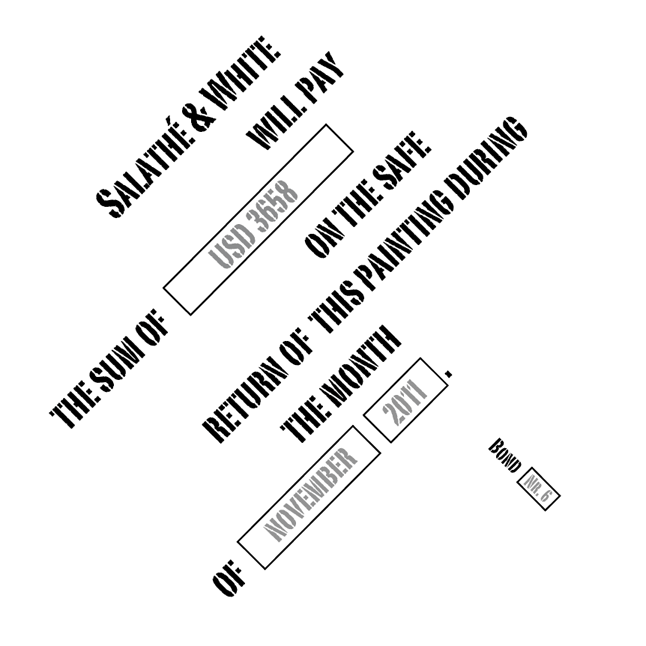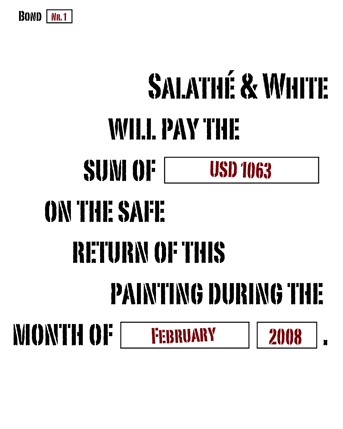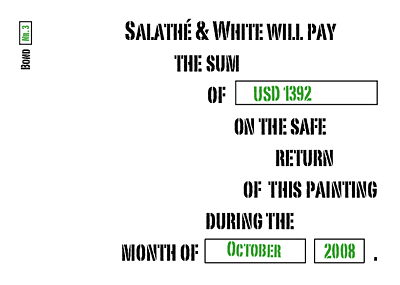 Marcel Salathé and Anthony White are a pair of artists undertaking a somewhat perplexing experiment involving art and economics. They take a canvas, paint words on it promising to pay a certain sum of money to the person who returns it to them, provided that person returns it during the month denoted on the painting. It looks like this.
Marcel Salathé and Anthony White are a pair of artists undertaking a somewhat perplexing experiment involving art and economics. They take a canvas, paint words on it promising to pay a certain sum of money to the person who returns it to them, provided that person returns it during the month denoted on the painting. It looks like this.You can think of it sort of like a certificate of deposit, except that it's on a square yard of canvas, and, if the maturity date expires, it won't roll over into a new CD; instead, you can't redeem it at all after that date.
My expectation would be that the novelty of a giant certificate of deposit that you can hang on the wall of your urban loft-style apartment with exposed ductwork would make these paintings sell at higher prices than CDs of the same face value that you purchase from your bank. Effectively, the artists ought to be able to offer a lower annual percentage yield (APY) than a bank does, because of the purported aesthetic value of the painting. In practice, this expectation has not always been borne out.
 The series so far consists of six paintings, four of which have been sold. The maturity dates of two of the four sold paintings have passed (Bond Nos. 1 and 3). Bond No. 1 is pictured here to my left. Bond No. 1 promised $1,063 if it was returned during February 2008. The piece was sold at auction for $1,286. The painting was not returned, and so the artists netted $1,286. That's a good result for them. Not only did they sell a promise to pay $1,063 for more than $1,063, but the promise lapsed without being enforced. Not bad.
The series so far consists of six paintings, four of which have been sold. The maturity dates of two of the four sold paintings have passed (Bond Nos. 1 and 3). Bond No. 1 is pictured here to my left. Bond No. 1 promised $1,063 if it was returned during February 2008. The piece was sold at auction for $1,286. The painting was not returned, and so the artists netted $1,286. That's a good result for them. Not only did they sell a promise to pay $1,063 for more than $1,063, but the promise lapsed without being enforced. Not bad. To my right now you'll see Bond No. 3, which promised $1,392 if returned during October 2008. Bond No. 3 was sold at auction on April 29, 2008 for $960, and was returned to the artists in October 2008. The artists then paid the returning party $1,392, and auctioned the painting again on eBay, where it sold this time for $242.50. All told, the artists netted a loss of $189.50 on Bond No. 3.
To my right now you'll see Bond No. 3, which promised $1,392 if returned during October 2008. Bond No. 3 was sold at auction on April 29, 2008 for $960, and was returned to the artists in October 2008. The artists then paid the returning party $1,392, and auctioned the painting again on eBay, where it sold this time for $242.50. All told, the artists netted a loss of $189.50 on Bond No. 3.It seems to me that Bond No. 3 was worth well more than $960 when it was purchased, and that the reason it sold for so little must have had to do with the thin market (i.e., the fact that not many people knew about the auction). If you bought a CD for $960 that promised a return of $1,392 in five months, its interest rate would be 89%. That comes to a 144% APY. For comparison, if you buy a six-month CD from Chase today, it will buy you a measly 0.25% APY. Bond No. 3 was a steal at $960.
After Bond No. 3, the artists apparently learned their lesson, and stopped auctioning the paintings. Instead, they placed a fixed price on them. Bond No. 6, pictured at the top, lists for $2,699, and promises $3,658 if returned in November 2011. The comparable CD would have an interest rate of about 10.4%, for roughly an 11% APY, nowhere near as crazy high as Bond No. 3, but still a much, much better rate of return than would be available from a bank right now. In fact, an 11% APY is higher than you'd ordinarily expect in a decent year from stocks (and Lord knows we may be waiting a long time for another one of those); on a guaranteed investment 11% APY is mind-blowing. I say buy it if you have the cash on hand.
But doesn't this seem strange? Like I said above, the aesthetic value of the art ought to mean that the artists should be able to offer lower yields than banks. Instead they offer higher ones. It's almost like the aesthetic/novelty factor actually makes the painting worth less than a traditional CD. Are Salathé and White making a paradoxical or ironic statement about art values? Or are they just not performing the calculations that would tell them that they are grossly undervaluing their work?
Is this for real? Should I get one?
ReplyDeleteAll the research I did while I was writing this seemed to indicate that this was totally for real. Before you buy one you'll probably want to adjust the purchase price (and recalculate the APY) accounting for shipping charges. Shipping appears to be the buyer's responsibility both initially and upon return, but the artists guarantee it will cost less than $100 US. I'm not sure whether that's for both trips or or per trip. If you're interested, you could contact them and ask.
ReplyDeleteIncidentally, you might also ask the artists whether the painting is "negotiable." If it is, that means that you can sell it to someone else prior to the maturity date, and that person would be able to claim the face value at the maturity date. If the painting is non-negotiable, then the purchaser is the only one who can claim the face value, meaning it would be really hard to unload the painting for a profit prior to the maturity date.
ReplyDeleteIn general, a negotiable instrument is more valuable than a non-negotiable one.